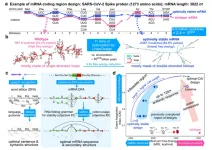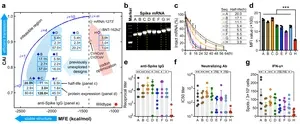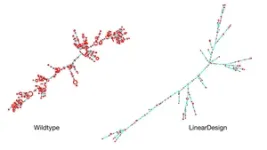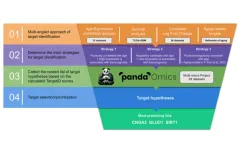(Press-News.org)
A team of researchers from Baidu Research has developed an AI algorithm that can rapidly design highly stable COVID-19 mRNA vaccine sequences that were previously unattainable. The algorithm, named LinearDesign, represents a major leap in both stability and efficacy for vaccine sequences, achieving a 128-fold increase in the COVID-19 vaccine’s antibody response.
“This research can apply mRNA medicine encoding to a wider range of therapeutic proteins, such as monoclonal antibodies and anti-cancer drugs, promising broad applications and far-reaching impact,” said Dr. He Zhang, Staff Software Engineer at Baidu Research.
Through a collaboration with Oregon State University, StemiRNA Therapeutics, and the University of Rochester Medical Center, the study “Algorithm for Optimized mRNA Design Improves Stability and Immunogenicity” appeared in the scientific journal Nature today through Accelerated Article Preview (AAP). This marks the first time a Chinese tech company has been credited as the first affiliation on a paper published in Nature.
The paper reveals how a complex biology problem can be tackled by taking a classic approach from natural language processing (NLP), using an elegantly simple solution that has been employed to understand words and grammar.
mRNA, or Messager RNA, has emerged as a revolutionary technology for vaccine development and potential treatments against cancer and other diseases. Serving as a vital messenger that carries genetic instructions from DNA to the cell’s protein-making machinery, mRNA enables the creation of specific proteins for various functions in the human body. With numerous advantages in safety, efficacy, and production, mRNA has been swiftly adopted in the process of COVID-19 vaccine development.
However, the natural instability of mRNA results in insufficient protein expression that weakens a vaccine’s capacity to stimulate strong immune responses. This instability also poses challenges for storing and transporting mRNA vaccines, especially in developing countries where resources are often limited.
Previous research has shown that optimizing the secondary structure stability of mRNA, when combined with optimal codons, leads to improved protein expression. The challenge lies in the mRNA design space, which is incredibly vast due to synonymous codons. For instance, there are approximately 10^632 mRNAs that can be translated into the same SARS-CoV-2 Spike protein, presenting insurmountable challenges for prior methods.
Though NLP and biology may at first glance appear unrelated, the two fields share strong mathematical connections. In human language, a sentence consists of a word sequence and an underlying syntactic tree with noun and verb phrases, which together convey meaning. Likewise, an RNA strand has a nucleotide sequence and an associated secondary structure based on its folding pattern.
Researchers used a technique in language processing called lattice parsing, which represents potential word connections in a lattice graph and selects the most plausible option based on grammar. Similarly, they created a graph that compactly represents all mRNA candidates, using deterministic finite-state automaton (DFA). Applying lattice parsing to mRNA, finding the optimal mRNA is akin to identifying the most likely sentence among a range of similar-sounding alternatives.
Using this approach, LinearDesign takes a mere 11 minutes to generate the most stable mRNA sequence that encodes Spike protein.
In a head-to-head comparison, the sequences designed by LinearDesign exhibited significantly improved results compared to existing vaccine sequences. For COVID-19 mRNA vaccine sequences, the algorithm achieved up to a 5-fold increase in stability (mRNA half-life), a 3-fold increase in protein expression levels (within 48 hours), and an incredible 128-fold increase in antibody response. For VZV mRNA vaccine sequences, the study reported up to a 6-fold increase in stability (mRNA molecule half-life), a 5.3-fold increase in protein expression levels (48 hours), and an 8-fold increase in antibody response.
“The vaccines designed through our method may offer better protection with the same dosage, and potentially provide equal protection with a smaller dose, leading to fewer side effects. This will greatly reduce the vaccine research and development costs for biopharmaceutical companies while improving the outcomes,” Dr. Zhang added. In 2021, Baidu and Sanofi began a partnership to integrate the LinearDesign algorithm into Sanofi's product design pipeline for mRNA vaccine and drug development.
Baidu has created a bio-computing platform based on PaddlePaddle called PaddleHelix, which encompasses the ERNIE-Bio-Computing Big Models. This platform explores the application of AI in various fields, such as small molecules, proteins/peptides, and RNA, offering a novel research paradigm for AI in life sciences. Baidu’s ERNIE Big Model has developed a comprehensive big model technology system, covering NLP, vision, cross-modal, and bio-computing. The recently unveiled ERNIE Bot, a knowledge-enhanced large language model (LLM) capable of understanding and generating human language, is part of the ERNIE Big Model family.
Moving forward, Baidu will continue to explore AI applications in life sciences, broadening the scope and depth of inclusive technology, and championing the health and well-being of all humanity.
About Baidu Research
Co-located in Beijing and Silicon Valley, Baidu Research brings together top talents from around the world to focus on future-looking fundamental research in artificial intelligence.
END
A team from the University of Illinois has modeled improving photosynthesis through enzyme modification and simulated soybean growth with realistic climate conditions, determining to what extent the improvements in photosynthesis could result in increased yields.
“There’s a complex relationship between photosynthesis improvement and actual yield, having higher photosynthesis doesn’t necessarily mean you have higher yield. The yield return is highly impacted by seasonal climate conditions” said Yufeng He, a postdoctoral researcher at Illinois, who led this work for a research project called Realizing Increased ...
“[...] AI-powered algorithms, such as PandaOmics, may accelerate subsequent gene target discovery not only for GBM but for a broader range of age-associated diseases.”
BUFFALO, NY- May 2, 2023 – A new research paper was published in Aging (listed by MEDLINE/PubMed as "Aging (Albany NY)" and "Aging-US" by Web of Science) Volume 15, Issue 8, entitled, “Identification of dual-purpose therapeutic targets implicated in aging and glioblastoma multiforme using PandaOmics - an AI-enabled biological target discovery platform.”
Glioblastoma Multiforme (GBM) is the most aggressive and most ...
Montreal — The North American Commission for Environmental Cooperation (CEC) today released a new report compiling and analyzing data reported by approximately 24,000 industrial facilities in Canada, Mexico and the United States to their respective national pollutant release and transfer registers. The report reveals important gaps in the reporting and tracking of transfers to disposal across the region due to differing reporting requirements, shared responsibilities across agencies and jurisdictions, and the lack of information about the fate of waste pollutants when they are transferred to third parties (such as waste management service providers) or across national ...
Cedars-Sinai Cancer welcomes Karine Sargsyan, MD, formerly director of one of the world’s largest clinical biobanks, as scientific director of its OncoBiobank. Sargsyan is charged with leading biobank development and creating new strategies for the optimal deployment and use of the Cedars-Sinai Cancer Molecular Twin Precision Oncology Platform for both research and clinical practice. She will work collaboratively with Nicholas Tatonetti, PhD, associate director of Computational Oncology, on the ...
ITHACA, N.Y. - In an effort to make textiles more sustainable, a new method allows researchers to break old clothing down chemically and reuse polyester compounds to create fire resistant, anti-bacterial or wrinkle-free coatings that could then be applied to clothes and fabrics.
The proof-of-principle study provides hope for unsustainable textile, apparel and footwear industries that together generate 20% of global solid waste. Many so-called recyclers end up illegally dumping textiles as trash in countries in Asia and Africa.
“We think that our clothes are recycled or reprocessed, but most ...
Joyful music could be a game changer for virtual reality headaches
Listening to music could reduce the dizziness, nausea and headaches virtual reality users might experience after using digital devices, research suggests.
Cybersickness – a type of motion sickness from virtual reality experiences such as computer games – significantly reduces when joyful music is part of the immersive experience, the study found.
The intensity of the nausea-related symptoms of cybersickness was also found to substantially decrease with both joyful and calming music.
Researchers from the University of Edinburgh assessed the effects of music ...
LAWRENCE — Governments and private contractors work together on countless functions, but when something goes wrong, who is to blame?
Zach Mohr, associate professor of public affairs & administration at the University of Kansas, is involved in a series of studies to examine how people determine blame and hold those in power accountable.
While research has shown deaths in prisons have increased in recent years, there is little public data available about how those deaths occur in specific ...
A University of Missouri School of Medicine researcher examining the circumstances behind pediatric firearm assaults found that most child shooting victims were shot outdoors for unknown reasons and were likely not intentionally targeted.
Firearm injuries surpassed motor vehicle accidents as the leading cause of child deaths in 2020. Assault has become the most common cause of firearm injury among American children and adolescents, surpassing firearm suicide and accidental firearm injuries. However, very little research exists examining the circumstances ...
About The Study: Over the last 10 years, the proportion of pediatric emergency department visits for mental health reasons have approximately doubled, including a 5-fold increase in suicide-related visits. These findings underscore an urgent need to improve crisis and emergency mental health service capacity for young people, especially for children experiencing suicidal symptoms.
Authors: Greg Rhee, Ph.D., of the University of Connecticut School of Medicine in Farmington, is the corresponding author.
To access the embargoed study: Visit our For The Media website at this ...
Bottom Line: The U.S. Preventive Services Task Force (USPSTF) recommends screening for latent tuberculosis infection (LTBI) in populations at increased risk. Populations at increased risk for LTBI based on increased prevalence of active disease and increased risk of exposure include persons who were born in, or are former residents of, countries with high tuberculosis prevalence and persons who live in, or have lived in, high-risk congregate settings (e.g., homeless shelters or correctional facilities). The precise prevalence rate of LTBI in the U.S. is difficult to determine; however, estimated prevalence is about 5.0%, or up to 13 million persons. ...






